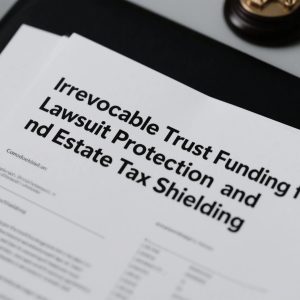The Fundamentals of Umbrella Liability Protection
Umbrella liability coverage serves as an essential financial safety net for individuals and businesses facing potentially catastrophic lawsuits. This supplemental insurance kicks in when the limits of your standard policies – like auto, homeowners, or business liability – have been exhausted. Picture it as an extra layer of security hovering above your existing coverage, ready to deploy when claim amounts exceed your primary policy limits. The protection typically starts at $1 million in coverage and can extend to $10 million or more, depending on your insurer and risk profile. What makes these policies particularly valuable is their broad coverage scope, often filling gaps left by underlying insurance and covering claims that other policies might exclude.
High-net-worth individuals frequently discover they need high net worth insurance solutions like umbrella policies because their visible assets make them attractive lawsuit targets. When someone wins a judgment against you that exceeds your auto or homeowners policy limits, creditors can come after your personal assets – your home, investments, and even future earnings. An umbrella policy creates a protective moat around your entire financial kingdom. The coverage extends beyond just monetary payouts too – most policies cover legal defense costs, which can be astronomical in complex liability cases. These defense costs often deplete policy limits before settlements even occur, making the additional coverage even more critical.
Calculating Your Optimal Coverage Amount
Determining how much umbrella liability coverage you need requires careful assessment of both your assets and potential exposure points. Financial advisors typically recommend coverage equal to your net worth plus projected future earnings. For business owners, this calculation should include both personal and business assets since plaintiffs often target both in lawsuits. Consider that jury awards in liability cases frequently reach seven figures, especially in regions known for plaintiff-friendly verdicts. A $2 million judgment might wipe out someone with $1.5 million in assets, but adequate umbrella coverage would prevent this financial catastrophe.
Your lifestyle factors heavily into legal risk insurance needs assessment. Do you own a swimming pool, trampoline, or aggressive dog breed? These are what insurers call “attractive nuisances” that increase liability exposure. Frequent hosting of parties or employing domestic staff also elevates risk. Business owners with customer interactions face additional vectors for potential claims. The umbrella policy’s value lies in its ability to cover these varied risks under one comprehensive shield rather than requiring separate policies for each exposure point. Remember that coverage needs compound when you have teenage drivers in the household – their mistakes behind the wheel could become your financial responsibility.
How Umbrella Policies Interface with Other Coverage
A common misconception about excess liability policy structures is that they simply add dollar amounts to existing coverage. In reality, umbrella policies often provide broader protection than underlying policies while maintaining the same exclusions. For example, your auto insurance might exclude certain types of vehicle-related lawsuits that your umbrella policy would cover once the auto limits are exhausted. This “drop down” feature makes umbrella coverage particularly valuable for filling coverage gaps. However, insurers typically require you to maintain certain minimum limits on underlying policies before they’ll issue an umbrella policy – usually around $300,000 for auto and $500,000 for homeowners.
The coordination between primary and umbrella liability coverage becomes crucial during claims. When a covered loss occurs, your primary insurer handles the claim up to its limits before the umbrella policy engages. This layered approach creates efficiency in claims handling while ensuring maximum protection. Business owners should pay particular attention to how commercial umbrella policies interact with general liability, professional liability, and employment practices coverage. The interplay between these policies often requires expert review to avoid coverage gaps that could leave substantial assets unprotected. An insurance professional can help map these relationships and ensure seamless coverage transitions.
Unique Protections Offered by Umbrella Policies
Beyond just increasing liability limits, quality high net worth insurance packages through umbrella policies provide several often-overlooked benefits. Many cover defamation, libel, and slander claims – critical protection in our social media-driven world where offhand comments can spark expensive lawsuits. They frequently include worldwide coverage, protecting you during international travel when foreign laws might expose you to unfamiliar liability risks. Some policies even cover false arrest, malicious prosecution, or wrongful eviction claims that standard homeowners policies exclude. These expansive protections make umbrella coverage particularly valuable for public figures, landlords, and professionals with high visibility.
The psychological benefits of robust legal risk insurance shouldn’t be underestimated either. Knowing you have substantial coverage allows you to live and conduct business without constant fear of financial ruin from an unexpected lawsuit. This peace of mind proves particularly valuable for professionals in litigation-prone fields like medicine, law, or real estate development. The policies also provide access to top-tier legal defense teams that insurers retain for major claims – lawyers who might otherwise be prohibitively expensive. This defense benefit alone can justify the policy’s cost, as quality legal representation dramatically impacts lawsuit outcomes.

Cost-Benefit Analysis of Umbrella Coverage
The relatively modest premium for excess liability policy protection often surprises first-time buyers. For $1 million in coverage, individuals might pay just $150-$300 annually, with each additional million costing proportionally less. This pricing reflects insurers’ actuarial data showing that few claims ever reach umbrella layers. However, those that do can be financially devastating without proper protection. The cost-benefit equation becomes even more favorable when you consider that umbrella policies often cover all household members, including children away at college. Some policies even extend to rental properties or occasional business activities that standard homeowners policies exclude.
Business owners evaluating business risk coverage options should note that commercial umbrella policies follow similar cost patterns. Premiums typically run 10-15% of the underlying general liability policy cost, with discounts available for strong loss histories and risk management programs. The premium represents a tiny fraction of potential exposure – a single uncovered lawsuit could cost years of profits. Many businesses structure their coverage with a primary general liability policy of $1-2 million topped by a $5-10 million umbrella policy, creating robust protection at manageable costs. The exact structure should match the company’s specific risk profile and asset base.
Special Considerations for High-Net-Worth Individuals
Wealthy individuals often require customized high net worth insurance solutions that standard umbrella policies can’t provide. Their unique asset portfolios – including fine art, vintage cars, or wine collections – may need special valuation considerations in liability scenarios. Many pursue excess liability coverage through private client divisions of major insurers that offer higher limits and more flexible terms. These specialized policies might include worldwide liability protection for multiple homes, coverage for domestic staff injuries, or protection against claims arising from serving on nonprofit boards. The underwriting process for these policies is more thorough, often requiring detailed asset inventories and risk assessments.
The visibility of wealth creates additional legal risk insurance needs that umbrella policies address. High-profile individuals face greater risks of defamation claims, invasion of privacy lawsuits, or allegations of improper influence. Their children might become targets for “social host” liability claims if alcohol is served at parties. Even charitable activities can generate liability exposure if someone claims harm from a sponsored event. Comprehensive umbrella coverage for affluent families should anticipate these unique vulnerabilities and include appropriate endorsements. Working with specialized brokers ensures the policy reflects actual lifestyle risks rather than just generic coverage templates.
Business-Specific Umbrella Policy Applications
Commercial umbrella liability coverage operates similarly to personal policies but addresses distinct business risks. A single product liability claim or workplace accident could generate damages far exceeding standard general liability limits. Businesses with physical locations need protection against premises liability claims, while service firms require coverage for professional liability exposures. The umbrella policy provides crucial excess coverage across all these areas. Companies undergoing mergers or acquisitions often temporarily increase umbrella limits to cover unknown liabilities that might emerge during transition periods.
Certain industries particularly benefit from robust business risk coverage through umbrella policies. Construction firms face inherent jobsite dangers that can lead to catastrophic injury claims. Manufacturers risk product-related lawsuits that can span multiple jurisdictions. Technology companies need protection against evolving cyber liabilities and intellectual property disputes. Retailers require coverage for customer injury claims that can spiral into seven-figure verdicts. In each case, the umbrella policy provides financial breathing room when major claims occur, often making the difference between business continuity and bankruptcy.
Common Exclusions and Coverage Gaps
While comprehensive, excess liability policy protections aren’t limitless. Most exclude intentional acts, professional liability (unless specifically endorsed), and workers compensation claims. Business owners might need separate policies for employment practices liability or directors and officers coverage. Personal umbrella policies typically exclude business-related liabilities unless specifically added by endorsement. Understanding these boundaries is crucial to avoid dangerous coverage assumptions. For example, a homeowner’s umbrella policy won’t cover liability from a home-based business unless specifically arranged with the insurer.
The contractual liability exclusion in many business risk coverage policies creates another potential gap. If your business signs contracts assuming liability that wouldn’t otherwise exist (common in construction or service agreements), standard umbrella policies might not cover these assumed obligations. Environmental liability is another frequent exclusion that might require separate pollution policies. Careful policy review with an experienced broker can identify these gaps and arrange appropriate endorsements or separate coverage. Never assume your umbrella policy covers all potential liabilities – explicit confirmation from your insurer is essential.
Claims Scenarios and Real-World Protection
Understanding how umbrella liability coverage functions in actual claims illustrates its value. Consider a car accident where you’re at fault, causing multiple serious injuries. Medical bills, lost wages, and pain/suffering claims could easily exceed $1 million – beyond standard auto policy limits. Without umbrella coverage, your personal assets would cover the excess. With proper coverage, the umbrella policy handles amounts above your auto limits. Similarly, if a guest drowns in your pool and their family sues for $2 million, the umbrella policy would cover amounts above your homeowners liability limit.
Business examples of legal risk insurance protection are equally compelling. A customer slipping in your store might result in a $3 million verdict for permanent disability. A defective product could injure multiple users, generating class action litigation. An employee’s harassment claim might result in seven-figure damages. In each case, the umbrella policy provides the extra financial protection needed to weather these storms. Real-world claims often involve unexpected scenarios – the neighbor’s child injured while playing on your property, a social media post misinterpreted as defamatory, or a volunteer event that goes wrong. Umbrella coverage provides broad protection across these varied situations.
Emerging Risks and Future Coverage Trends
The evolving risk landscape continuously reshapes high net worth insurance needs. Cyber liability exposures have grown exponentially, with wealthy individuals targeted for digital extortion and fraud. Some forward-thinking umbrella policies now include limited cyber liability coverage. Social media-related liabilities represent another growing exposure area, with defamation and privacy claims arising from online activity. Even drone ownership creates new liability vectors that traditional policies might not adequately address. Insurers are gradually adapting umbrella products to cover these modern risks, though specific endorsements may be necessary.
Looking ahead, business risk coverage through umbrella policies will likely expand to address autonomous vehicle liabilities, artificial intelligence-related claims, and climate change litigation risks. The gig economy creates new hybrid personal/commercial liability exposures that standard policies struggle to classify. International business operations face evolving liability regimes in different jurisdictions. Savvy insurance buyers should regularly review their umbrella coverage with brokers to ensure it keeps pace with these developing risks. The most comprehensive policies will increasingly offer modular endorsements that allow customization for emerging threat scenarios.
Implementation Strategies for Optimal Protection
Securing the right umbrella liability coverage requires proactive planning rather than reactive purchasing. Start by consolidating your insurance with a single provider when possible, as insurers often give better umbrella terms when they also underwrite your underlying policies. Maintain impeccable risk management practices – insurers may deny umbrella claims if they find you negligent in preventing losses. Document all risk reduction measures like pool fences, driver training programs, or workplace safety initiatives, as these can positively influence both premiums and claims outcomes.
For businesses, integrating legal risk insurance with overall risk management creates powerful protection. Combine your umbrella policy with strong contracts, thorough employee training, and disciplined safety protocols. Regularly review coverage limits as your business grows or enters new markets. Consider periodic liability audits to identify emerging exposures before they generate claims. The most effective protection combines adequate insurance with proactive risk prevention – the umbrella policy serves as your financial backstop when prevention measures fall short. This dual approach provides both immediate protection and long-term risk reduction.





